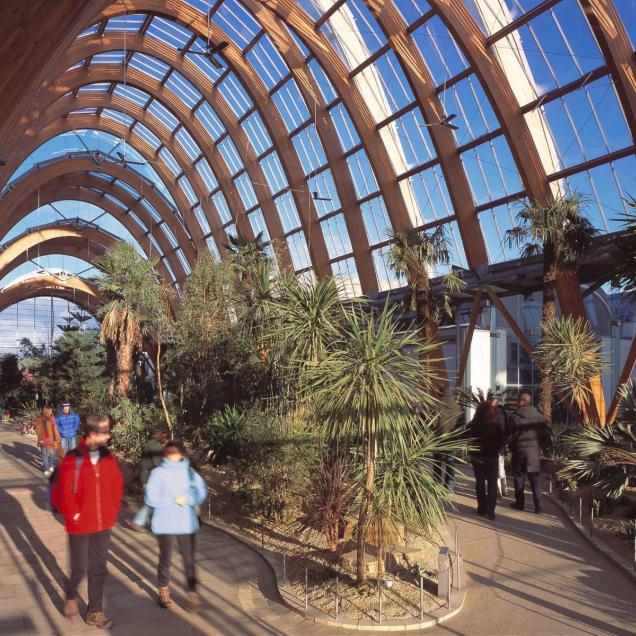

Arts: Winter wonderland of glass
They call it the Winter Gardens. It's Europe's biggest modern glasshouse and its startling domes erupt gracefully from a key site in the city centre. But will it do Sheffield any good - or is it just a pounds 7m blister, a bit of architectural flash covering urban meltdown with a glittering patina of change?
The question hangs in the air, and will continue to do so until the braid of this city's Millennium Lottery-funded makeover projects have been in place long enough to tell whether they can make a lasting difference. Sheffield like Manchester, Newcastle and now Liverpool - is in the regeneration big league. But, unlike the other three, it has already suffered a stigmatic failure in one of its big projects.
Within a year of opening, the National Centre for Popular Music was mothballed. Designed by Nigel Coates, this otherwise delightful piece of architecture was in the wrong place at the wrong time. Sheffield couldn't guarantee enough "foot-fall" to keep it going; and south-easterners failed, quite predictably, to mass at St Pancras for poptastic awaydays to Yorkshire. Great building, utterly duff strategic siting.
But Sheffield is some place, and not least a vigorously surviving example of effective town planning. In terms of street layout, the city's core is blessed. There is no rectilinear grid, as such; instead, many streets intersect at irregular angles, giving textbook variations in vistas and a sense of openness to the urban landscape. There is, of course, a flipside: large-scale architectural incursions and wrenches of infrastructure become instantly problematic.
Like Coates's charming architectural alien, the Winter Gardens constitute good architecture. Unlike the Centre for Popular Music, they are locked into a grander scheme. And that's what will probably make the difference; in urban renewal, bright ideas often work best en masse. And even the unglamorous moves can have terrific effects. The decision to convert Arundel Gate - which separates a big chunk of the university quarter from the town centre - from dual carriageway into two lanes was one such quiet masterstroke.
Nevertheless, it's the Winter Gardens that form the centrepiece of Sheffield's Heart of the City regeneration scheme, developed by the Sheffield First consortium, chaired by Jan Wilson, the leader of Sheffield City Council. The glasshouse, which rises in four well- proportioned "steps", links the Peace Gardens fronting the magnificently obdurate City Hall to the new Millennium Galleries and, at the other end, to Tudor Square.
The architects responsible for the glasshouse and the galleries are Pringle, Richards and Sharratt. The galleries have, like the Peace Gardens two years ago, won significant architectural awards. Will the Winter Gardens follow suit? Well, it's certainly more dramatic than the galleries, whose virtues are rather self-effacing; apart from some over-fussy exterior detailing, the gallery can be said to be well-proportioned, clean-limbed, a soothing vanilla-toned haven - but it's not, in itself, particularly engaging as architecture.
The Winter Gardens offer a quite different experience. Wisely, the architects have resisted any over-egging of their timber and glass palette. They've used glue-laminated larch to form the dozen or so low-maintenance parabolic arches that carry the glazing. It's been simply done, with no show-off connections or details. And so it has, rather fittingly, the simple grace of that most wonderful of Victorian arches - the train shed at St Pancras station.
Standing inside this structure, we get the full architectural and engineering story; we see exactly what sits on top of what, and how everything is held up. It's naked architecture, see-through in every sense, and makes a pleasant change to smoothed over, look-no-hands design. And it feels robust and purposeful, just the sort of gaff to nurture the Norfolk Island pines and the Chusan palms.
The Winter Gardens will accentuate the outstanding success of the Peace Gardens. This public square may well be the best new city centre open space in Britain. It looks good, fronts up the City Hall without making an aesthetic meal of it and, from day one, gathered people to it almost magnetically. And now this space has been backed up by another whose ambience and use is not affected by inclement weather.
But reservations remain. As the keystone of the pounds 130m Heart of the City development, the Winter Gardens is part of a private sector deal with developers, MacDonalds, which will lead to a hotel being built along the City Hall side of the structure. The hotel will obviously overshadow part of the Winter Gardens; and, depending on its design, may dump an unpleasant vibe on the Peace Gardens.
Plainly, something interesting is happening to Sheffield's commercial critical mass - and new architecture is at the heart of it. But can the Winter Gardens stimulate even more investment? It pulled in 130,000 visitors this month; good going, but not yet decisive indication of its longer- term potency as a brand-mark for the city, and its role as the crucial connective tissue linking the Peace Gardens to Tudor Square.
© The Independent 2003